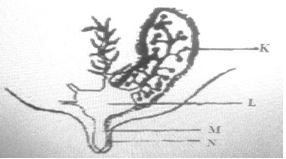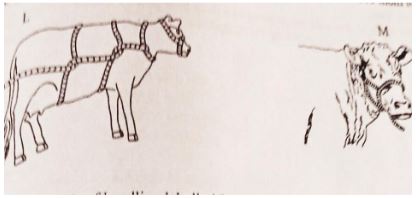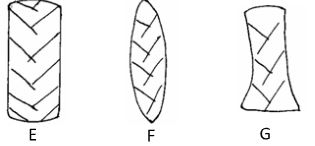INSTRUCTIONS TO CANDIDATES
- This paper consists of three sections: A, B and C.
- Answer all the questions in section A and B and any two questions from section C
- All answers must be written in the spaces provided in this paper
SECTION A (30 MARKS)
Answer all the questions in this section in the spaces provided
- Name four beef breeds of cattle. (2 marks)
- State four observations on the behavior of chicks which would indicate that the temperature in the brooder is too high. (2 marks)
- Give four practices carried out on fish before preservation. (2 marks)
- Outline four reasons for steaming up a gestating cow. (2 marks)
- List four factors considered when selecting eggs for marketing. (2 marks)
- Give four disorders associated with calcium deficiency in livestock (2marks)
- State four advantages of carrying out raddling in sheep management. (2 marks)
- Give a reason why ruminant animals are able to digest grass. (1 mark)
- Give the difference in meaning of the following terms as used in livestock.
- Quarantine and Isolation (1 mark)
- Zoonotic and notifiable diseases (1 mark)
- List four effects of ticks on livestock bodies. (2marks)
- State four factors that influence selection of construction materials. (2 marks)
- Name three farm implements operated by the tractor’s P.T.O shaft. (11/2marks)
- State four reasons for debeaking in poultry production. (2 marks)
- Name three breeding diseases controlled through the use of artificial insemination. (11/2marks)
- Give four characteristics of a good vaccine. (2 marks)
- State four advantages of Kenya top bar hive in bee keeping. (2 marks)
SECTION B (20 MARKS) - The diagram below shows the udder of a cow. Use it to answer the questions that follow.
- Name parts L and M. (2 marks)
L -
M- - State the hormone responsible for milk let down. (1 mark)
- Define dry cow therapy. (1 mark)
- Why milking should be done quickly and evenly. (1 mark)
- Name parts L and M. (2 marks)
- The diagrams below show some farm tools. Study them and answer the questions that follow.
- Name the tools. (2 marks)
A-
B-
C-
W- - State the functional differences between tools K and W. (1mark)
- What advantage does C have over A and B? (1 mark)
- State one common maintenance practice carried out tool C and W. (1mark)
- Name the tools. (2 marks)
- The diagram below shows two methods of handling livestock in the farm. Study them and answer the questions that follow.
- Identify the methods of handling livestock labelled L and M. (1 mark)
L
M - Give two occasions when it may be necessary to carry out the practice labelled L above. (2 marks)
- Give two animal conditions under which method L above cannot be used. (2 marks)
- Identify the methods of handling livestock labelled L and M. (1 mark)
- The diagram below represents conditions of the tyre.
- Which diagram represents the correct pressure in a tractor tyre? (1 mark)
- Identify the mistakes with the other two tyres. (2 marks)
- Give the correct measures taken for each tyre mentioned in (b) above. (2 marks)
SECTION C (40 MARKS)
Answer any two questions in this section
-
- Explain five factors that affect milk composition in dairy farming. (5 marks)
- State five signs of parturition in cattle (5marks)
- State five maintenance practices of a fish pond (5marks)
- Explain five factors considered when selecting livestock for breeding (5marks)
-
- Describe the management of a sow during parturition. (10 marks)
- Describe the lifecycle of a three host tick. (7 marks)
- Outline three effects of endo-parasites to the host animals (3marks)
-
- Describe a blue tick (Boophilus decolaratus) under the following sub-headings.
- Diseases transmitted. (2marks)
- Preferred site of attachment. (3marks)
- Non-chemical control measures. (5marks)
- Discuss mastitis disease under the following sub-headings:
- Predisposing factors. (5marks)
- Control and treatment. (5marks
- Describe a blue tick (Boophilus decolaratus) under the following sub-headings.
MARKING SCHEME
SECTION A (30 MARKS)
Answer all the questions in this section in the spaces provided
- Name four beef breeds of cattle. (2 marks)
- Galloway
- Hereford
- Beef short horns
- Charolaise
- Aberdeen angus
- Four observations on the behavior of chicks which would indicate that the temperature in the brooder is too high. (2 marks)
- Drinking too much water
- Beaks open
- Moves away from the heat source
- Spreading wings
- Lying flat on the ground
- Making noise
- Give four practices carried out on fish before preservation. (2 marks)
- Cleaning the fish to remove mud and worms
- Cleaning the abdominal cavity
- Keep fish in open containers
- Remove scales and slime
- Opening the fish on the side to remove gut and the intestines
- Outline four reasons for steaming up a gestating cow. (2 marks)
- Hastens foetus growth and development
- Assists in the formation of colostrum
- Provide nutrients for the cow and the developing foetus
- Provides energy required during parturition
- List four factors considered when selecting eggs for marketing. (2 marks)
- Shape of the eggs
- Colour of the shell
- Size of the eggs
- Cleanliness of the eggs
- Free from abnormalities
- Disorders associated with calcium deficiency in animals
- Milk fever
- Soft shelled eggs
- Egg without shells (shell-less eggs)
- Osteomalacia/osteoporosis
- Rickets Any 4 x ½ (2mks)
- State four advantages of carrying out raddling in sheep management. (2 marks)
- To identify the sire of the lamb
- To identify barren ewes
- To identify infertile rams
- To identify the most fertile ewes
- Give a reason why ruminant animals are able to digest grass. ( 1 mark)
- They have micro-organisms/bacteria in the rumen which help to breakdown cellulose.
- Give the difference in meaning of the following terms as used in livestock health.
- Quarantine and Isolation (1mark)
Quarantine.- Laws by the government banning movement of livestock and their products into and out of an area during the period of an outbreak of a notifiable or highly contagious and infectious disease.
Isolation. - Separating and confining a sick animal from the rest of the herd to prevent spread of a highly contagious disease
(Mark as a whole)
- Laws by the government banning movement of livestock and their products into and out of an area during the period of an outbreak of a notifiable or highly contagious and infectious disease.
- Zoonotic and notifiable diseases (1 mark)
- Zoonotic - A disease that can be transmitted from livestock to humans and vice versa
- Notifiable - highly contagious and infectious disease whose outbreak should be reported to the authority.
(Mark as a whole)
- Quarantine and Isolation (1mark)
- List four effects of ticks on livestock bodies. (2marks)
- They suck large volumes of blood causing anaemia
- They lower the quality of hides and skins
- They cause irritation
- They transmit livestock diseases
- State four factors that influence selection of construction materials. (2 marks)
- Farmers taste and preference
- The cost of the materials
- Workability of the materials
- Durability of the materials
- Availability of the materials
- Name three farm implements operated by the tractor’s P.T.O shaft. (11/2marks)
- Mowers
- Shellers
- Rotavators
- Forage harvesters
- State four reasons for debeaking in poultry production. (2 marks)
- To control cannibalism in birds
- To minimize egg eating
- To control toe pecking
- To control feather plucking
- Name three breeding diseases controlled through use of artificial insemination. (11/2marks)
- Brucellosis
- Trichomoniasis
- Vibrio is
- Vaginitis
- orchitis
- Give four characteristics of a good vaccine. (2 marks)
- Immunity it produces must be as good as natural immunity
- Should have a long keeping life
- Should be easy to administer to the animal
- Should have no side effects when administered into the animal’s body
- Should be compatible with other vaccines
- State four advantages of Kenya top bar hive in bee keeping. (2 marks)
- Easy to inspect the hive without disturbing the brood combs
- High quality honey is produced
- Cheap to construct as it uses locally available materials
- Harvesting of honey is easy
SECTION B (20 MARKS)
-
- Name parts L and M
- L - Gland cistern
- M - Teat cistern (1 x 1= 1 marks)
- State the hormone responsible for milk let down. (1mk)
- Oxytocin (1 x 1= 1 marks)
- Define dry cow therapy. (1mk)
- Application of antibiotics in the teats of a cow during the drying off period to avoid mastitis infection (1 x 1= 1 marks)
- Why should milking be done very quickly and evenly. (1mark)
- The effect of oxytocin lasts for a very short time (5 to 7 minutes).the animal may hide milk. (1 x 1= 1 marks
- Name parts L and M
-
- Name the tools. (2 marks)
- A - Open-end spanner
- B - Rig spanner
- C - Adjustable spanner
- W - Burdizzo
- State the functional differences between tools K and W. (1mark)
- K - Expands rubber ring to facilitate to facilitate closed castration, docking and dehorning
- W - used for closed castration in bull calves, rams and Billy goats
- Advantage of tool C, over tool A and B
- Tool C, can be used to open and tighten nuts and bolts of deferent sizes while A and B can only be used to open or tighten nuts and bolts of specific sizes.
- Common maintenance of tool C and W
- Lubricating/oiling moving parts
- Name the tools. (2 marks)
- The diagram below shows two methods of handling livestock in the farm. Study them and answer the questions that follow.
- Identify the methods of handling labelled L and M. (1 mark)
- L - casting
- M - use of a halter
- Give two occasions when it may be necessary to carry out the practice labelled L above. (2 marks)
- During examination
- During castration
- During dehorning
- When branding
- Give two animal conditions under which the method L above cannot be used. (2 marks)
- When the animal is in calf
- When the animal is fully fed
- Identify the methods of handling labelled L and M. (1 mark)
-
- E (1mark)
- F - High pressure / excess pressure (1mark) G - Low pressure / less pressure. (1mark)
-
- F - Deflate to correct. (1mark)
- G - Inflate to correct. (1mark)
SECTION C
-
- Factors affecting milk composition (5mks)
- Age of the animal
- Physiological Condition of the animal
- Stage of lactation and pregnancy
- Completeness of milking
- Breed differences
- Season of the year
- Type of feed eaten by the animal
- Other factors such as mastitis disease
- Signs of parturition in cattle
- Restlessness
- Enlarged /swollen vulva
- Clear mucus discharge from vulva
- Full and distended udder
- Slackening of the pelvic muscles/relaxing of the hips muscles
- Thick milky fluid (colostrum) from teats
- Appearing and bursting of the water bag/sac
- Loss of appetite
- Isolating from others (5x1=5marks)
- Maintenance practices of a fish pond
- Clearing the bush/vegetation around the pond
- Cleaning the pond
- Desilting/removing the silt
- Planting grass on the dyke
- Repairing worn out parts/dykes
- Maintain the water level.
- Fertilize the pond
- Fencing (5x1=5marks)
- Factors considered when selecting livestock for breeding
- Age – select young animals
- Level of performance – select animals with the highest production level/high Performers or yielders.
- Physical fitness – animals selected should be free from physical deformities/defects e.g. limping, mono-eyed
- Health – Select healthy animals/animal selected should be health
- Body conformation – Animals selected should have proper body conformation e.g. dairy cow to be wedge shaped with a large udder.
- Temperament/behavior – select animals with good temperament/behavior
- Quality of products – select animals that give good quality products
- Mothering ability – animals selected should have good mothering ability
- Adaptability – animals selected should be well adapted to local conditions.
- Prolificacy – selected animals that are highly prolific
- Fertility – selected animals that are fertile (5x1=5marks)
- Factors affecting milk composition (5mks)
-
- Describe the management of a sow during parturition.
- Deworm 7-10 days before parturition/spray the sow against external parasites/wash its body with soap and water.
- Take the sow to the farrowing pen at least 5-7 days before the expected date of parturition.
- Clean and disinfect the farrowing pen
- Provide creep area.
- Feed the sow entirely on bran.
- Provide clean bedding materials in the farrowing pen.
- Do not interfere but watch from a distance during farrowing.
- Assist where necessary.
- Ensure piglets are breathing.
- Perform artificial respiration.
- Ensure piglets are safe from being cannibalized by the sow.
- Tie, cut and disinfect the navel cord of the piglet.
- Weigh each piglet and record the birth weight.
- Remove and dispose off the after birth/any piglet born dead (still births).
- Put piglets in a warm place.
- Ensure piglets suckle colostrum.
- Get rid of excess piglets.
- Provide plenty of clean water after parturition.
- Feed the sow generously. (Any 10 x 1 = 10marks)
- Describe the lifecycle of a three host tick. (7 marks)
- Adult tick lay eggs on the ground.
- Eggs hatch into larvae on the ground.
- Larvae mount onto the first host.
- Larvae on host one feed to full engorgement and drop down.
- Nymphs mount second host suck blood until engorges.
- Nymphs drop down.
- Nymphs moults into adults.
- Adults mount third host, suck blood to full engorgement.
- Adults drop down to repeat cycle. (7 x1 = 7 marks)
- Outline three effects of endo-parasites to the host animals (3marks)
- They suck blood leading to anaemia
- They deprives the host of its food
- They damage internal organs like liver
- Cause obstruction of bile duct and alimentary canal
- Describe the management of a sow during parturition.
-
-
-
- Red water/babeiosis.
- Anaplasmosis/gull sickness. (2x1=2marks)
-
- face
- neck
- base of horns
- tail brush
- dewlap
- ears
- eyes (any 3x1=3marks)
-
- Double fencing
- Hand picking and killing.
- Controlled grazing/rotational grazing.
- Burning infested pastures.
- Ploughing of infested pastures
- Predator birds. (Any 5x1=5marks)
-
-
-
- Age
- Stage of lactation period.
- Udder attachment.
- Incomplete milking.
- Mechanical injury.
- Poor sanitation.
- Poor milking technique. (Any 5x1=5mks)
-
- Empty affected quarter of udder and instill antibiotics.
- After milking, use teat dip on every quarter.
- Use right milking technique
- Observe strict cleanliness.
- Use dry cow therapy
- Use strip cup to detect infection.
- Use separate udder cloths for each animal. (Any 5x1=5mks)
-
-
Download Agriculture Paper 2 Questions and Answers - Lanjet Joint Mock Exams 2023.
Tap Here to Download for 50/-
Get on WhatsApp for 50/-
Why download?
- ✔ To read offline at any time.
- ✔ To Print at your convenience
- ✔ Share Easily with Friends / Students



